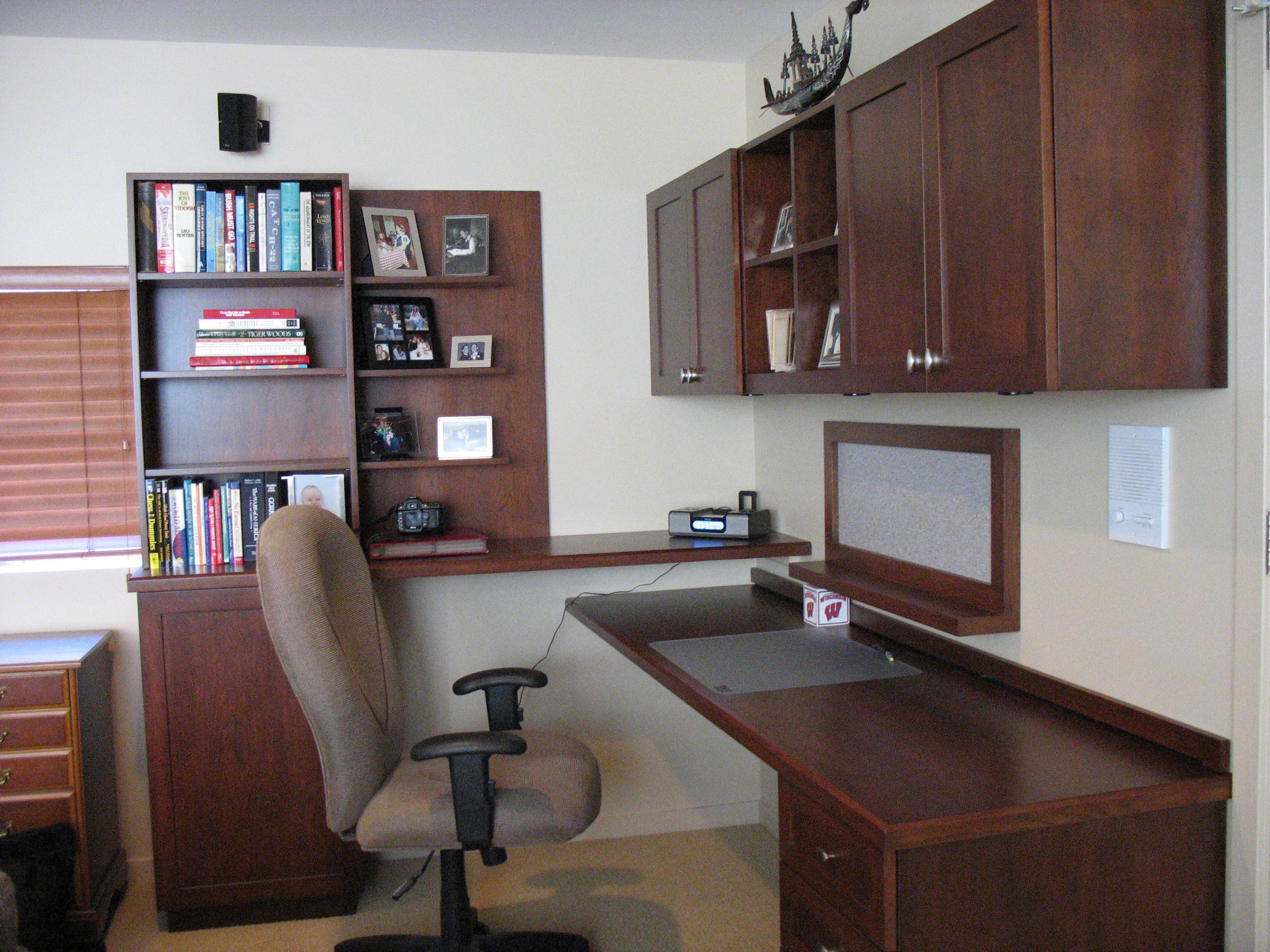In our 24-7-365 world, we all work at home “some” of the time, whether we like it or not.
Most of us do this from the couch or comfort of our beds, knowing this isn’t the best method for maximizing productivity.
Which makes “now” the time to go beyond the dining room table turned desk and create personal workspace that is both efficient and beautiful.
Enter Mr. and Mrs. “Client” and their family room. They bought a townhome with a really large family room and wanted to be able to have it serve double duty as a space for family activities in the evening and work activities during the day.

They also wanted the style and wood stain to match some existing pieces of furniture.
Each one wanted their own desk area within the room. And they had separate requirements.
She does a lot of photo printing and scrapbooking in addition to her computer work activities.
He works mostly on the computer and needed some legal storage. He also wanted a bulletin board right in front of him to function as a reminder source for the projects he was working on.

Design Guidelines For Beautiful, Functional Results
These guidelines are for you, the designer. I’d ask different questions of the client and not expect them to have an awareness of all the construction/installation issues involved in creating a custom work area.
Average depth on a desk top is 24”. Thirty inches feels better to me if you like to spread out files and work on things, so I often have the desktop extend over the cabinets. On the other hand, in a tight space - you can get away with 18” in depth.
I like a return or back credenza for more work surface and I design it so it’s not as deep as the desktop; often 16” or 18” deep.

I typically leave about 18” - sometimes 16” - between the upper and lower cabinets.
I like the configuration of a file drawer on the bottom and two more shallow drawers above - for paper, pencils and office supplies.
Access to electricity is important and should always be a part of the discussion - although wireless connections can remove that issue. Still, power is the name of the game these days. People plugging in phones and tablets and laptops, so having access to power really is key.
Actual size of equipment is of the utmost importance. There is no such thing as an average size printer - the client must tell me the specifications of any equipment that needs to be stored before I do a design.
Allow for a couple of inches for the actual “plug” - this is often about 2 inches - so when you’re calculating depth - make sure you add that into overall total or the doors might not close when the equipment is plugged in.
Be cognizant of door swings so they work with how the person is sitting in the space.
Be aware of whether or not you are going to see both sides of the desk - front and back. If so, more finished cabinetry is required.
I never build a desk in pieces (the way we build most closet systems) - only as boxes/cabinets.
It would not hurt to “shop” some wire management options - Mockett has cool ones -though pricey - but since it’s a piece that gets used alot and seen alot- I think it’s worth it for the style factor. I don’t have any favorites.
I like to include the hardware for hanging files in the file drawers and prefer the plastic strips that slide onto the left and right side of the drawer box. The metal framework you buy at office supply stores doesn’t feel as elegant to me.
Handling the corners
I really, really dislike the idea of having someone face the corner and handling the desk in the manner that most people do - with a traditional corner cabinet. I know it’s been standard policy in the kitchen and cabinet industries because it works as a base solution with a lazy susan, but we’re talking about home offices here. You can see from the photos that I didn’t make corner shelving units and I don’t have the clients facing that corner as their work space.
A Mistake
No one likes making them and we all hope to learn from them.
So, I’m admitting to you that I made what could be considered a very “rookie” mistake on this project. I neglected to account for the depth of the cables behind the cabinetry.
I’ve never made that mistake again.
Once you write a check to fix something, it tends to become ingrained in your business acumen not to repeat that mistake. So I’m now diligent about getting EXACT measurements and specifications on ANY equipment.
Personal workspace is probably the most quickly evolving space in the home. We can now do it from the comfort of our bed or do it standing up at a desk that raises and lowers based on our preferences (and ailments!). Stay tuned if you want to help your clients be their most productive.







Have something to say? Share your thoughts with us in the comments below.